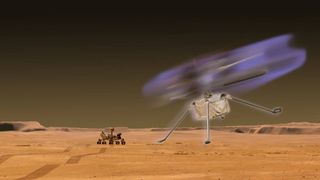Why Mars helicopters like Ingenuity could glow in the dark
You can blame dust in the wind.

Helicopters making dusk flights on Mars might glow in the dark.
A new study suggests that Mars drones, such as the Ingenuity helicopter making periodic sorties on the Red Planet, "may cause tiny electric currents to flow in the Martian atmosphere," according to NASA.
The potential currents are not a threat to the helicopter, if they do indeed arise in the first place, but would create an interesting effect for any cameras that are nearby. More broadly, the study provides an avenue to better understand the accumulation of electric charge on rotor blades, known as "triboelectric charging."
"The faint glow would be most visible during evening hours when the background sky is darker," study lead author Bill Farrell, a plasma scientist at NASA's Goddard Space Flight Center in Maryland, said in the same statement. Regretfully, he added, Ingenuity is an experimental drone not cleared to fly at dusk or dawn, but we might be able to observe the effect on future Martian helicopters.
Related: Watch Ingenuity Mars helicopter soar in amazing new videos from Perseverance rover
The process by which Martian drones might glow is similar to common effects on Earth from electrical currents, including corona or electrical glow sometimes seen on aircraft, along with ships in electrical storms known as St. Elmo's Fire, NASA said.
Triboelectric charging occurs during friction that moves electrical charge between objects, which you can commonly see when a person rubs a balloon against their hair on Earth. The balloon then "attracts" the person's hair, showing evidence of the electric field induced by the rubbing.
Get the Space.com Newsletter
Breaking space news, the latest updates on rocket launches, skywatching events and more!
Laboratory measurements and computer models suggest that when Martian drones spin their blades, they encounter dust grains from the constant storms and dust devils on the Red Planet's surface.
"As the blades impact the grains, charge is transferred, building up on the blades and creating an electric field," NASA said in the statement. "As charge builds to high levels, the atmosphere starts to conduct electricity, a process known as 'atmospheric breakdown.' [The process is] creating a population of electrons that form an enhanced electric current that acts to dissipate or offset the charge build-up on the rotorcraft."

A study based on this research was published March 10, 2021 in the Planetary Science Journal, and NASA chose to highlight the study in a press release this week on Tuesday (Feb. 1).
The study was published before the Perseverance rover and Ingenuity landed on Mars on Feb. 18, 2021; nearly a year later, Ingenuity has made 18 flights and spent more than 30 minutes aloft during these various sorties.
Follow Elizabeth Howell on Twitter @howellspace. Follow us on Twitter @Spacedotcom or Facebook.
Join our Space Forums to keep talking space on the latest missions, night sky and more! And if you have a news tip, correction or comment, let us know at: community@space.com.

Elizabeth Howell (she/her), Ph.D., is a staff writer in the spaceflight channel since 2022 covering diversity, education and gaming as well. She was contributing writer for Space.com for 10 years before joining full-time. Elizabeth's reporting includes multiple exclusives with the White House and Office of the Vice-President of the United States, an exclusive conversation with aspiring space tourist (and NSYNC bassist) Lance Bass, speaking several times with the International Space Station, witnessing five human spaceflight launches on two continents, flying parabolic, working inside a spacesuit, and participating in a simulated Mars mission. Her latest book, "Why Am I Taller?", is co-written with astronaut Dave Williams. Elizabeth holds a Ph.D. and M.Sc. in Space Studies from the University of North Dakota, a Bachelor of Journalism from Canada's Carleton University and a Bachelor of History from Canada's Athabasca University. Elizabeth is also a post-secondary instructor in communications and science at several institutions since 2015; her experience includes developing and teaching an astronomy course at Canada's Algonquin College (with Indigenous content as well) to more than 1,000 students since 2020. Elizabeth first got interested in space after watching the movie Apollo 13 in 1996, and still wants to be an astronaut someday. Mastodon: https://qoto.org/@howellspace
